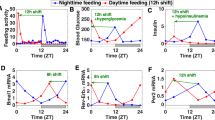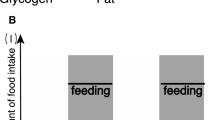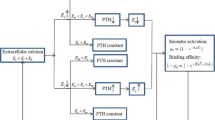Abstract
The relevance of nonlinear dynamics to calcium metabolism led us to reevaluate the role of Ca-regulating hormones in Ca homeostasis. We suggest that, firstly, the main Ca metabolic functions in rat-bone and gut - are organized as dynamic entities able to generate various temporal expressions, including self-oscillating patterns and, secondly, Ca homeostasis results from interaction between both metabolic and hormonal oscillators. Following this schema, a major role for the hormonal system, with its circadian pattern, could be to act directly on metabolic functions or indirectly through feeding behaviour, in order to optimize, coordinate and synchronize the Ca fluxes at ECF level.
Similar content being viewed by others
References
Garside, J. and R.J. Davey (1980). Secondary contact nucleation: kinetics, growth and scale-up. Chem. Eng. Commun. 4: 393–424.
Larson, M.A. and Garside, J. (1986). Solute clustering and interfacial tension. J. Crystal Growth 76: 88–92.
Lausson, S., J.F. Staub, G. Milhaud and A.M. Perault-Staub (1985). Circadian variations in plasma calcium and calcitonin. J. Endocrinology 107: 389–395.
Lausson, S., N. Segond, G. Milhaud and J.F. Staub (1989). Circadian rhythms of calcitonin gene expression in the rat. J. Endocrinology 122: 527–534.
Markowitz, M.E., S. Arnaud, J.F. Rosen, M. Thorphy and S. Laximinaryan (1988). Temporal interrelationships between the circadian rhythms of serum parathyroid hormone and calcium concentrations. J. Clin. Endocrinol. Metab. 67: 1068–1073.
Miller, B. and A.W. Norman (1979). Evidence of a circadian rhythm in the activity of the 25-hydroxyvitamin-D3–1-hydroxylase. Biochem. Biophys. Res. Commun. 88: 730–734.
Moore-Ede, M.C., F.M. Sulzman and C.A. Fuller (1982). The Clocks that Time Us. Harvard University Press.
Neer, R.M. (1989). Calcium and inorganic phosphate homeostasis. In: L.L. DeGroot, ed. Endocrinology. Saunders Company Vol. 2: 927–954.
Neuman, M.W. (1982). Blood/bone equilibrium. Calcif. Tissue Res. 34: 117–120.
Perault-Staub, A.M., J.F. Staub and G. Milhaud (1974). A new concept of plasma calcium homeostasis. Endocrinology 95: 480–484.
Roelfsema, F., D. van der Heide, J. Poulis and D. Smeenk (1983). Diurnal urinary calcium and phosphate excretion patterns in parathyroidectomizedrats. J. Interdispl. Cycle Res. 14: 305–314.
Rusli, I.T., G.L. Schrader and M.A. Larson (1989). Raman spectroscopy study of NaNO3 solution system-solute clustering in supersaturated solutions. J. Crystal. Growth 97: 345–351.
Segel, L. A. Modeling Dynamic Phenomena in Molecular and Cellular Biology. Cambridge University Press.
Staub, J.F., A.M. Perault-Staub and G. Milhaud (1979). Endogenous nature of circadian rhythms in calcium metabolism. Am. J. Physiol. 237: R311-R317.
Staub, J.F., P. Tracqui, P. Brezillon, G. Milhaud and A.M. Perault-Staub (1988). Calcium metabolism in the rat: A temporal self-organized model. Am. J. Physiol. 254: R134-R149.
Staub, J.F., P. Tracqui, S. Lausson, G. Milhaud and A.M. Perault-Staub (1989). A physiological view of in vivo calcium dynamics: the regulation of a non linear self-organized system. Bone 10: 77–86.
Talmage, R.V., S.A. Grubb, H. Norimatsu and C.J. Vanderwiel (1980). Evidence for an important physiological role for calcitonin. Proc. Natl. Acad. sci. USA 77: 609–613.
Tracqui, P., A.M. Perault-Staub, G. Milhaud and J.F. Staub (1987). Theoretical study of a two-dimensional autocatalytic model for calcium dynamics at the extracellular fluid-bone interface. Bull. Math. Biol. 49: 597–613.
Tracqui, P., J.F. Staub and A.M. Perault-Staub (1989). Analysis of degenerate Hopf bifurcations for a non linear model of calcium metabolism. Non Linear Analysis: theory, Methods and Applications 13: 429–457.
Wrobel, J. and G. Nagel (1979). Diurnal rhythm of active transport in rat intestine. Experientia 35: 1581–1582.
Yates, F.E. (1982). System analysis of hormone action. In: R.F. Goldberger & K.R. Yamamoto, eds. Biological Regulation and Development, 25–97. New York, Plenum Press.
Author information
Authors and Affiliations
Rights and permissions
About this article
Cite this article
Perault-Staub, A.M., Tracqui, P. & Staub, J.F. Modelling of in vivo calcium metabolism. I. Optimal cooperation between constant and rhythmic behaviours. Acta Biotheor 40, 95–102 (1992). https://doi.org/10.1007/BF00168138
Published:
Issue Date:
DOI: https://doi.org/10.1007/BF00168138




